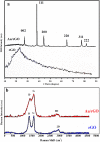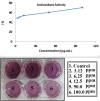Facile fabricating of rGO and Au/rGO nanocomposites using Brassica oleracea var. gongylodes biomass for non-invasive approach in cancer therapy
- PMID: 34099785
- PMCID: PMC8184758
- DOI: 10.1038/s41598-021-91352-7
Facile fabricating of rGO and Au/rGO nanocomposites using Brassica oleracea var. gongylodes biomass for non-invasive approach in cancer therapy
Abstract
In this study, we report a facile green-synthesis route for the fabrication of reduced graphene oxide (rGO) using biomass of Brassica oleracea var. gongylodes (B. oleracea). In addition, we have attempted to provide a green synthesis approach to prepare Gold nanoparticles (Au NPs) on the surface of rGO by using stem extract of B. oleracea. The synthesized Au/rGO nanocomposite was evaluated using UV-visible and FTIR spectroscopy, XRD, Raman, FE-SEM, EDX, AFM and DLS techniques. The obtained results demonstrated that the synthesized Au NPs on the surface of rGO was spherical with sizes ranging about 12-18 nm. The Au/rGO NC was, also, developed as photo-synthesizer system for the photothermal therapy (PTT) of MCF7 breast cancer cells. The near-infrared (NIR) photothermal properties of Au/rGO NCs was evaluated using a continuous laser at 808 nm with power densities of 1 W.cm-2. Their photothermal efficacy on MCF7 breast cancer cells after optimizing the proper concentration of the NCs were evaluated by MTT assay, Cell cycle and DAPI staining. In addition, the potential of the synthesized Au/rGO NCs on reactive oxygen species generating and antioxidant activity were assessed by DPPH. Au/rGO NCs possess high capacity to light-to-heat conversion for absorption in range NIR light, and it is able to therapeutic effects on MCF7 cells at a low concentration. The maximum amount of cell death is 40.12% which was observed in treatment groups that received a combination of Au/rGO NCs and laser irradiation. The results demonstrate that the nanomaterials synthesized by green approach lead to efficient destruction of cancer cell and might thus serve as an excellent theranostic agent in Photothermal therapy applications.
Conflict of interest statement
The authors declare no competing interests.
Figures








Similar articles
-
Green and facile synthesis of gold/perlite nanocomposite using Allium Fistulosum L. for photothermal application.Photodiagnosis Photodyn Ther. 2021 Jun;34:102243. doi: 10.1016/j.pdpdt.2021.102243. Epub 2021 Mar 4. Photodiagnosis Photodyn Ther. 2021. PMID: 33677069
-
A novel non-invasive strategy for low-level laser-induced cancer therapy by using new Ag/ZnO and Nd/ZnO functionalized reduced graphene oxide nanocomposites.Artif Cells Nanomed Biotechnol. 2018;46(sup2):800-816. doi: 10.1080/21691401.2018.1470523. Epub 2018 May 15. Artif Cells Nanomed Biotechnol. 2018. PMID: 29764213
-
SnO2-Doped ZnO/Reduced Graphene Oxide Nanocomposites: Synthesis, Characterization, and Improved Anticancer Activity via Oxidative Stress Pathway.Int J Nanomedicine. 2021 Jan 8;16:89-104. doi: 10.2147/IJN.S285392. eCollection 2021. Int J Nanomedicine. 2021. PMID: 33447029 Free PMC article.
-
Ag and Au nanoparticles/reduced graphene oxide composite materials: Synthesis and application in diagnostics and therapeutics.Adv Colloid Interface Sci. 2019 Sep;271:101991. doi: 10.1016/j.cis.2019.101991. Epub 2019 Jul 17. Adv Colloid Interface Sci. 2019. PMID: 31376639 Review.
-
Engineering ultrasmall gold nanoclusters: tailored optical modulation for phototherapeutic and multimodal biomedical applications.Chem Commun (Camb). 2025 May 30;61(45):8120-8136. doi: 10.1039/d5cc02027a. Chem Commun (Camb). 2025. PMID: 40391500 Review.
Cited by
-
One-Pot Synthesis of SnO2-rGO Nanocomposite for Enhanced Photocatalytic and Anticancer Activity.Polymers (Basel). 2022 May 16;14(10):2036. doi: 10.3390/polym14102036. Polymers (Basel). 2022. PMID: 35631918 Free PMC article.
-
From e-waste to eco-sensors: synthesis of reduced graphene oxide/ZnO from discarded batteries for a rapid electrochemical bisphenol A sensor.RSC Adv. 2024 Nov 11;14(48):36073-36083. doi: 10.1039/d4ra04046e. eCollection 2024 Nov 4. RSC Adv. 2024. PMID: 39529742 Free PMC article.
References
-
- Ferlay, J. et al. GLOBOCAN 2012 v1. 0, cancer incidence and mortality worldwide: IARC CancerBase No. 11. Lyon, France: International agency for research on cancer 2016 (2013).
-
- Jafarirad S, Hammami Torghabe E, Rasta SH, Salehi R. A novel non-invasive strategy for low-level laser-induced cancer therapy by using new Ag/ZnO and Nd/ZnO functionalized reduced graphene oxide nanocomposites. Artif. Cells Nanomed. Biotechnol. 2018;46:800–816. doi: 10.1080/21691401.2018.1470523. - DOI - PubMed
Publication types
MeSH terms
Substances
LinkOut - more resources
Full Text Sources
Medical
Miscellaneous

